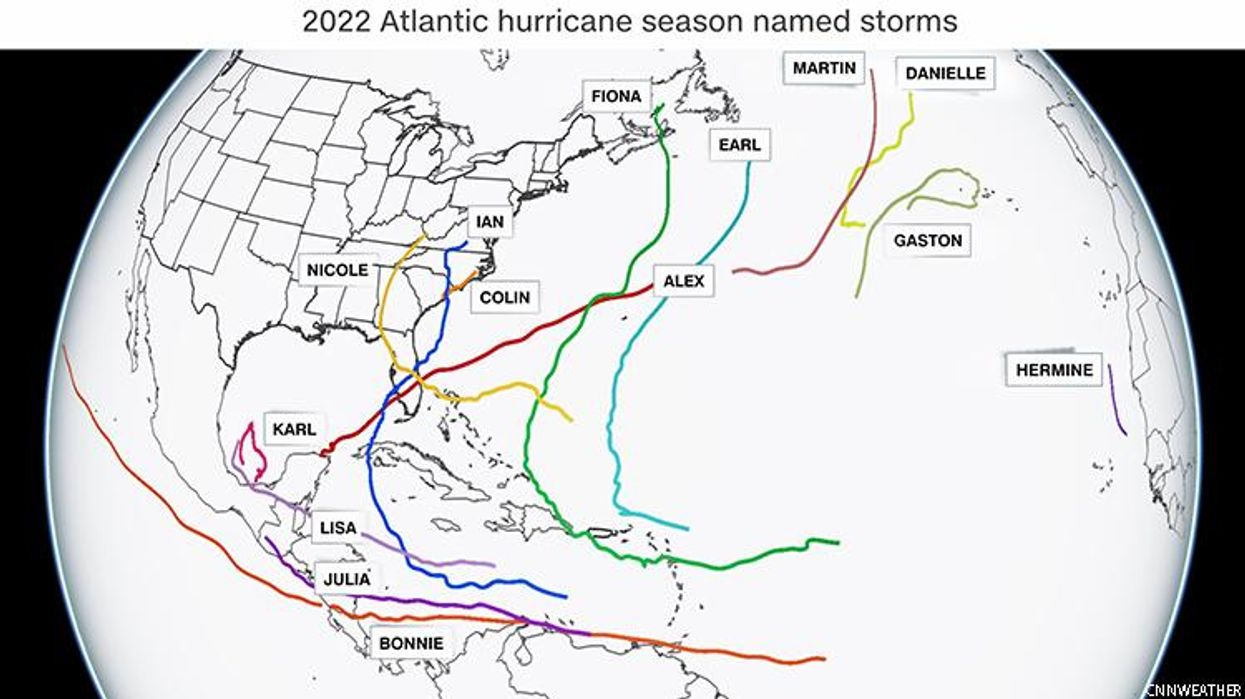News
Hurricane Season Started Slow, Finished with Destruction

Florida is still dealing with the cost and damage of the 2022 season.
November 30 2022 7:50 AM EST
By continuing to use our site, you agree to our Privacy Policy and Terms of Use.

Florida is still dealing with the cost and damage of the 2022 season.
(CNN) – As the hurricane season closes, a handful of blockbuster storms made history after a quiet first half of the season.
“Overall, the season was less active than we anticipated,” said Phil Klotzbach, research scientist at Colorado State University. “We (and most other groups) forecast an above-normal season, and the season ended up pretty much dead-on average.”
The season ended with 14 named storms, eight hurricanes, and two major hurricanes. An average season has 14 named storms, seven hurricanes, and three major hurricanes.
This was an average season by a simple storm count, but it was anything but average if you dig into the stats.
A quiet August was one of the most surprising things about the 2022 season. It was the first August without any named storms since 1997.
In fact, we didn't have any named storms from July 3 to August 31, the first time that's occurred since 1941.
“While the first two-thirds of the season were pretty anemic in an aggregate sense, it only takes one storm to make it an extremely damaging (and deadly) year,” Klotzbach said.
One of those storms was Hurricane Ian, which hit land in late September and will go down as the most memorable storm of the 2022 season. It led to more than 100 deaths, most by drowning, and more than more than $50 billion in estimated damages.
RELATED: Pics Show Ian’s Horrific Trail of Destruction
“When Ian became a hurricane, it was only the fourth hurricane of the year,” Klotzbach told CNN. “The average fourth hurricane forms on September 16, and Ian didn't reach that intensity until September 26.”
Ian’s forecast by the National Hurricane Center was dead on, but the storm surge came with an intensity never seen in Southwest Florida.
“Ian tied Hurricane Charley in 2004 as the strongest storm to make landfall on the west coast of the Florida Peninsula, both with 150 mph winds at landfall,” CNN meteorologist Brandon Miller said. “But the impacts of Ian were significantly worse given Ian was bigger and moving slower than Charley.”
Ian’s storm surge topped 10 to 15 feet, forcing people to rooftops. And that number could go even higher after the National Oceanic and Atmospheric Administration completes its post-storm analysis.
Ian’s slow movement caused widespread flooding well inland. Parts of central Florida picked up 12 to 18 inches of rain within 24 hours.
A portion of the St. John’s River in eastern Florida is still in flood stage, three months later.
Ian then made a second swipe at the US, slamming into South Carolina as a Category 1 storm two days after the initial Florida landfall.
The hurricane season turned off after Ian. Then in November, the tropics served up another wave of late-season activity with six named storms, four hurricanes, and two major hurricanes.
Hurricane Nicole was the first hurricane to strike anywhere in the US in the month in nearly 40 years, Miller said. “Also, making landfall just 42 days after Hurricane Ian, this is the shortest time period between Florida hurricane landfalls since 2004 when hurricanes Frances and Jeanne struck just 21 days apart.”
Nicole’s wind field stretched more than 500 miles, battering nearly the entire state with tropical storm force winds and impacting some of the same areas still rebuilding from Ian.
Outside of the US, one of the biggest surprises of the season was Hurricane Fiona in mid-September when it became the strongest storm to ever hit Canada.
RELATED: Will Hurricane Season Rain on Florida’s Tourism?
The storm reached Category 4 strength at one point, after battering portions of the Caribbean as a major storm.
Fiona then made landfall in Nova Scotia, Canada, with hurricane force winds and torrential rain.
The storm sent homes into the sea, wiped power out for hundreds of thousands, and left others surrounded by floodwater.
Klotzbach told CNN it’s hard to know how much of an impact climate change had on this season, but some truths about climate change hold regardless of the storm.
“Overall, as sea levels continue to rise, regardless of any increases in storm intensity and storm surge, we’re going to see water inundation penetrating farther inland, just given the background increase in sea level,” Klotzbach said. Adding, “We’re also likely to see more rainfall with a warmer atmosphere.”
The next hurricane season begins June 1, 2023, but storms can form outside the season, as well.
“Tropical storms have formed in every month outside of hurricane season, and there have been a few hurricanes, too," NOAA said.”
Historically, there have been 15 named storms formed in the month of December.
The-CNN-Wire
™ & © 2022 Cable News Network, Inc., a Warner Bros. Discovery Company. All rights reserved.